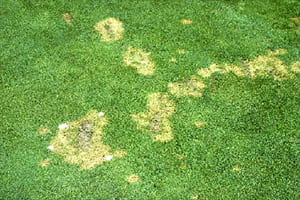Sports fields do not usually get many different diseases. For extra insurance when overseeding, be sure to use recommended varieties that have been proven to have disease resistance to lessen the chances of disease occurrence.
The valuable resource: Turfgrass Problems: Picture Clues and Management Options should be added to your management library. This resource lists the causal agent, shows the appearance of disease problems from a distance and close up, lists ideal conditions for disease to occur, notes which turfgrass species are affected and outlines cultural control options.
Turf disease factsheets can be found on the Cornell Turfgrass website, detailing disease symptoms, and management strategies.
The most common diseases found on cool season grasses used on sports fields include:
Rust
C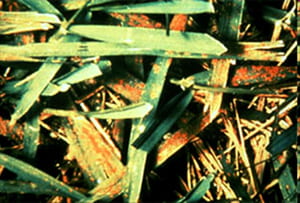 ornell Plant Disease Diagnostic Clinic factsheet
ornell Plant Disease Diagnostic Clinic factsheet
Affects all cool season grasses especially perennial ryegrass
Prevention and Cultural Control Strategies
- Maintain fertility for active growth throughout the season
- Minimize leaf wetness
- Irrigate to prevent drought stress
- Use tolerant cultivars
Red Thread
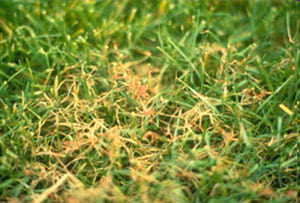 Cornell Plant Disease Diagnostic Clinic factsheet
Cornell Plant Disease Diagnostic Clinic factsheet
Perennial ryegrass and fine fescue are most susceptible. May also occur on tall fescue, bluegrass, bentgrass
Prevention and Cultural Control Strategies
- Maintain adequate and balanced fertility
- Reduce leaf wetness
- Water to avoid drought stress
- Moderately resistant cultivars are available
Dollar Spot
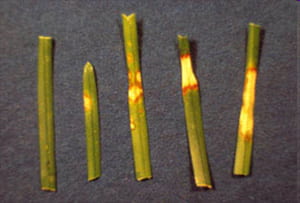 Cornell Plant Disease Diagnostic Clinic factsheet
Cornell Plant Disease Diagnostic Clinic factsheet
Affects all cool season grasses especially on fields not adequately fertilized
Prevention and Cultural Control Strategies
- Maintain adequate fertility
- Reduce compaction
- Minimize leaf wetness
- Water to avoid drought stress
- Plant tolerant cultivars
Brown Patch
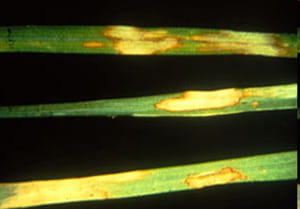 Cornell Plant Disease Diagnostic Clinic factsheet
Cornell Plant Disease Diagnostic Clinic factsheet
Affects all cool season grasses
Prevention and Cultural Control Strategies
- Maintain moderate, balanced fertility
- Minimize leaf wetness
- Alleviate compaction, maintain thatch < ¾”
- Promote good surface drainage
- Use tolerant cultivars
Pythium Blight
Purdue Pythium Blight Factsheet
Common on perennial ryegrass fields that have been heavily fertilized. Predictive models for Pythium Blight development can be found on the NRCC Turf website.
Prevention and Cultural Control Strategies
- Water early in the day to allow grass blades to dry
- Provide good surface and subsurface drainage
- Remove thatch greater than ½ inch
- Avoid quick-release or high nitrogen applications during hot, wet, humid conditions
Gray Leafspot
Cornell Plant Disease Diagnostic Clinic factsheet
Infects ryegrass and tall fescue especially during times of warm temperatures, high humidity and prolonged leaf wetness
- Avoid quick-release or high nitrogen applications during hot, wet, humid conditions
- Minimize leaf wetness
- Irrigate to avoid drought stress
- Improve drainage
- Alleviate compaction
If you are also able to use chemical control options use the latest pest management information found in the Cornell Guide for Commercial Turfgrass Management .
The chapter on turfgrass diseases in the Cornell Guide for Commercial Turfgrass Management covers the importance of correct diagnosis of turfgrass diseases, maximizing the use of fungicides for disease control, plant and pathogen factors affecting fungicide efficacy, handling and apply fungicides, record keeping, product updates, emerging issues and disease management.
Take the time to learn about these disease so you can plan a course of action should any of these diseases cause extensive damage.



